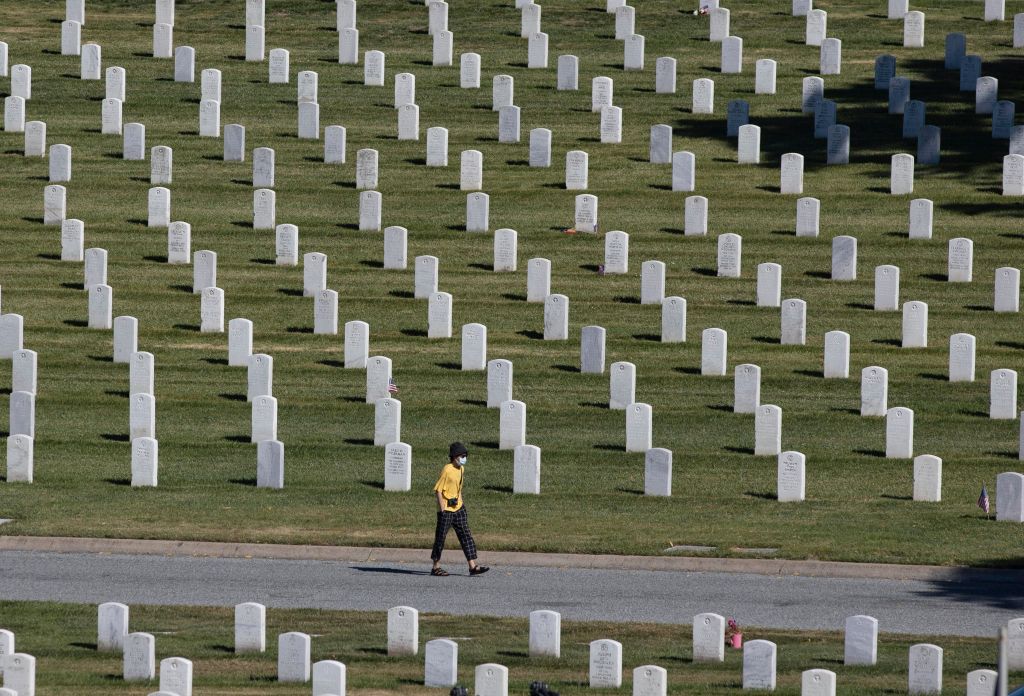
Four months after the first case of COVID-19 was confirmed in the U.S., the nation’s coronavirus death toll has surpassed 100,000, hitting 100,047 as of 6 p.m. Eastern Time on May 27, according to data compiled by the Center for Systems Science and Engineering at Johns Hopkins University.
That’s the most confirmed deaths of any country in the world. It’s equivalent to the entire population of mid-sized cities like Albany, N.Y. or Boca Raton, Fla. It’s more American lives than were lost to the Korean War, the Vietnam War and the Sept. 11, 2001 attacks combined.
It’s also on the low end of projected death estimates. In April, for example, White House officials warned that between 100,000 and 240,000 Americans could die from COVID-19, even with preventive measures like social distancing. Independent researchers have often produced even higher estimates. A Harvard health policy expert told NPR on May 26 that the U.S. could see an additional 100,000 COVID-19 deaths this summer alone.
Daily U.S. coronavirus cases and deaths have declined substantially since a peak in April—including in many of the country’s hardest-hit areas, like New York City—but experts have warned that rural areas may not have seen the worst of COVID-19 yet. And despite the progress we’ve seen so far, hundreds of people in the U.S. are still dying from coronavirus each day. During the week ending May 26, about 7,000 people in the U.S. died from COVID-19, according to data from Johns Hopkins University’s COVID-19 tracker.
Though new diagnoses are starting to decrease, the U.S. leads the world in coronavirus cases, as well as deaths. As of 6 PM eastern on May 27, nearly 1.7 million cases have been reported in the U.S., according to Johns Hopkins data. (That’s an underestimate, if anything, given inadequate testing capacity and the number of people who develop mild illnesses and do not seek medical attention.) And after steady declines in the numbers of new confirmed cases each day, the trend seems to have reversed itself in recent days.
That’s likely in part because the country’s commitment to social distancing appears to be faltering as states reopen and summer weather draws people out of their homes.
Though it may feel like the worst of the pandemic is behind us, a top World Health Organization official warned on May 26 that “we’re right in the middle of the first wave [of coronavirus cases] globally” and said “we’re still very much in a phase where the disease is actually on the way up” in many parts of the world.
It’s impossible to predict exactly when COVID-19 cases and deaths will level off for good. But experts do know that, in the absence of a vaccine that can provide widespread immunity, social distancing is among the best—and only—ways to keep infection, hospitalization and death rates as low as possible. A Columbia University analysis published May 20 estimated that 36,000 lives could have been saved if the U.S. broadly adopted social-distancing policies a week earlier than many places did, in mid-March.
The 100,000 lives already lost in the U.S. serve as a painful reminder of what happened instead.
More Must-Reads From TIME
- The 100 Most Influential People of 2024
- The Revolution of Yulia Navalnaya
- 6 Compliments That Land Every Time
- What's the Deal With the Bitcoin Halving?
- If You're Dating Right Now , You're Brave: Column
- The AI That Could Heal a Divided Internet
- Fallout Is a Brilliant Model for the Future of Video Game Adaptations
- Want Weekly Recs on What to Watch, Read, and More? Sign Up for Worth Your Time
Write to Jamie Ducharme at jamie.ducharme@time.com